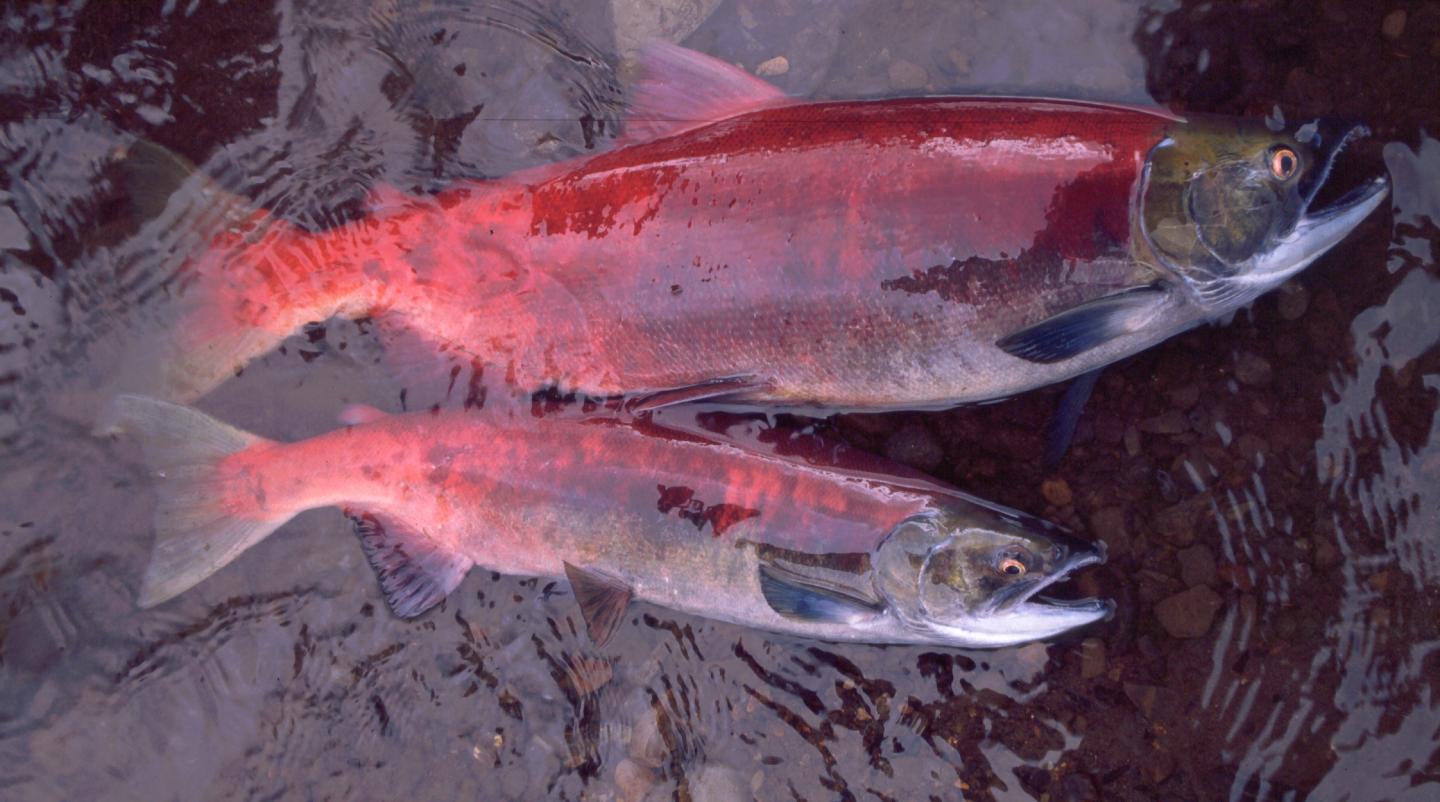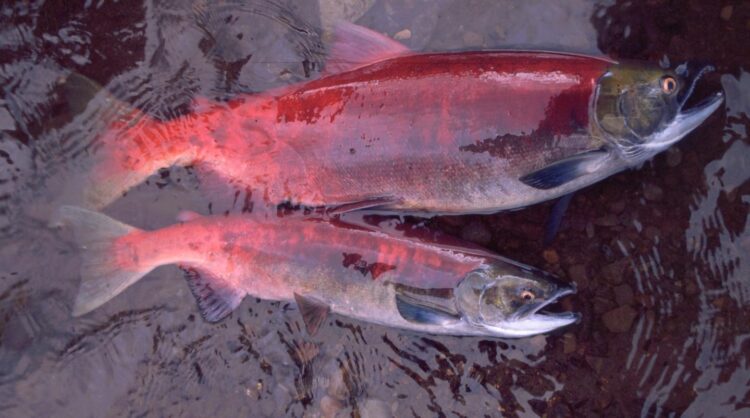A comprehensive study of four salmon species across all regions of Alaska finds salmon are returning to rivers smaller and younger than in the past

Credit: Andrew Hendry
The size of salmon returning to rivers in Alaska has declined dramatically over the past 60 years because they are spending fewer years at sea, according to a new study led by researchers at the University of California, Santa Cruz, and the University of Alaska Fairbanks.
Salmon are critically important to both people and ecosystems in Alaska, supporting commercial and subsistence fisheries and transporting nutrients from the ocean to inland areas, fertilizing the ecosystems in and around the rivers where they spawn. Smaller salmon provide less food for people who depend on them, less value for commercial fishers, and less fertilizer for terrestrial ecosystems.
For years, people in Alaska have been noticing that wild salmon were getting smaller, but the reasons have been unclear. In the new study, published August 19 in Nature Communications, researchers compiled and analyzed data collected over six decades (1957 to 2018) from 12.5 million fish by the Alaska Department of Fish and Game. This unprecedented dataset enabled them to see patterns of body size changes for four species of salmon–Chinook, chum, coho, and sockeye–across all regions of Alaska.
The results showed that the decreases in body size are primarily due to salmon returning to their spawning grounds at younger ages than they have in the past. Alaskan salmon can spend up to seven years at sea, although this varies by species. During this time they feed and grow to maturity, migrating great distances in the North Pacific Ocean before returning to fresh water to spawn.
“There are two ways they could be getting smaller–they could be growing less and be the same age but smaller, or they could be younger–and we saw a strong and consistent pattern that the salmon are returning to the rivers younger than they did historically,” said corresponding author Eric Palkovacs, professor of ecology and evolutionary biology and associate director of the Fisheries Collaborative Program in the Institute of Marine Sciences at UC Santa Cruz.
The researchers identified a range of factors that appear to be driving this shift, some acting across all regions and others affecting only certain species or populations.
“There’s not a single smoking gun,” said first author Krista Oke, a postdoctoral scientist initially at UC Santa Cruz and now at University of Alaska Fairbanks. “Small contributions from a lot of factors are adding up to drive these changes.”
Two factors–climate change and competition with growing numbers of wild and hatchery salmon in the ocean–have clearly contributed to size declines across all species and regions, Palkovacs said. In contrast, the effect of commercial fishing appears to be important only for some salmon populations. Similarly, the results were mixed for another proposed driver of size declines, the recovering populations of marine mammals that prey on salmon.
“We know that climate drives changes in ocean productivity, and we see a consistent signal of climate factors associated with decreasing salmon size,” Palkovacs said. “Another consistent association is with the abundance of salmon in the ocean, especially pink salmon. Their abundance in the North Pacific is at historic highs due in part to hatchery production in Alaska and Asia, and they compete with other salmon for food.”
The observation that salmon are returning to freshwater streams at younger ages implies that the ocean is becoming a riskier place for them to be, he said. By staying in the ocean longer and growing larger, salmon can have greater success in spawning and lay more eggs, but each additional year increases the risk of not returning to reproduce at all.
“Natural selection has always pushed in both directions, but the balance between the two is changing, pushing harder against the older, larger salmon,” Palkovacs said. “It seems that the ocean is becoming a riskier place to be.”
According to Oke, understanding exactly what is going on in the ocean to drive this shift is a difficult challenge that will require further study. “That’s the next hard step I hope we can get to soon,” she said. “It could be that they’re having to spend more time feeding, which is putting them in risky places. Lots of things could be happening to increase the overall risk of mortality in the ocean, but we weren’t able to pin that down.”
The consequences for people and ecosystems, however, are more clear. Smaller salmon means fewer meals per fish for subsistence fishers, lower profits for commercial fishers, fewer eggs laid to sustain salmon populations, and fewer nutrients to support the productivity and biodiversity of freshwater and riparian ecosystems.
“Smaller fish is a real problem for people who depend on salmon for their food and well being,” Oke said. “For commercial fishers, smaller fish tend to fetch lower prices, and below a certain size they can’t be made into high-value products and might have to be canned.”
On the ecosystem side, the nutrients delivered by salmon runs provide critical support for bears, insects, birds, trees, and juvenile salmon themselves. Palkovacs noted that an extensive body of research has tracked the movement of marine nitrogen from salmon into the terrestrial ecosystems around the streams where they spawn.
“Salmon go up into these small streams, and whether they are caught by predators or die after spawning, their nutrients are transferred into the forests and freshwater ecosystems,” he said. “It’s a classic salmon ecosystem service, and the amount of nutrients they deliver depends on their body size.”
The study had its origins in a working group organized by the National Center for Ecological Analysis and Synthesis (NCEAS) at UC Santa Barbara through its State of Alaska’s Salmon and People project. With funding from the Gordon & Betty Moore Foundation, the researchers were able to work with the Alaska Department of Fish and Game to compile data the agency had been collecting for decades, but which was dispersed among different field offices in various smaller databases.
“At NCEAS, we had two data scientists who compiled all the data into one massive database on Alaskan salmon that is now publicly available,” Palkovacs said. “It took a lot of time and energy, but that’s what enabled us to do this comprehensive analysis.”
Oke added that getting the data in the first place was no small task either. “When you think about the fact that we used data from 12.5 million salmon, that’s how many times someone from ADF&G measured a salmon. It’s an exceptional amount of work to make a dataset like this possible,” she said.
###
In addition to Oke and Palkovacs, the coauthors of the paper include corresponding author Peter Westley at University of Alaska Fairbanks, as well as researchers at Alaska Pacific University in Anchorage, UC Davis, UC Berkeley, NCEAS, McGill University in Montreal, Washington Department of Fish and Wildlife, Virginia Polytechnic Institute, Alaska Department of Fish and Game, Simon Fraser University, and Tanana Chiefs Conference, Fairbanks.
Media Contact
Tim Stephens
[email protected]
Related Journal Article
http://dx.





